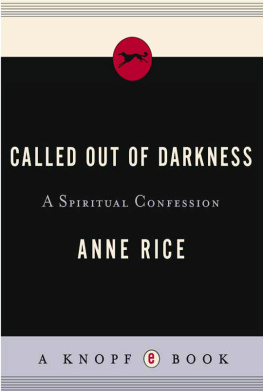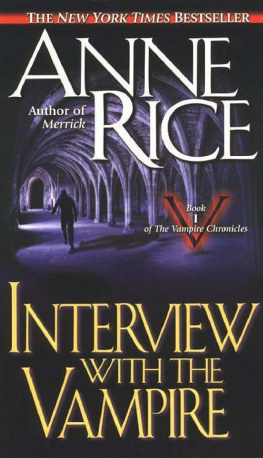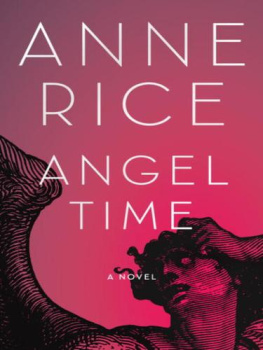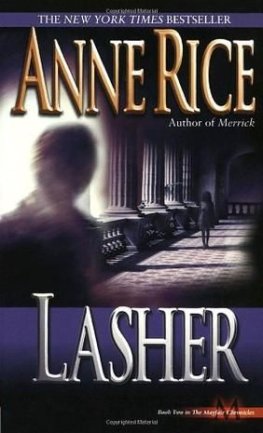Anne Rice - Called out of darkness: a spiritual confession
Here you can read online Anne Rice - Called out of darkness: a spiritual confession full text of the book (entire story) in english for free. Download pdf and epub, get meaning, cover and reviews about this ebook. City: New York, year: 2020, publisher: Alfred A. Knopf, genre: Religion. Description of the work, (preface) as well as reviews are available. Best literature library LitArk.com created for fans of good reading and offers a wide selection of genres:
Romance novel
Science fiction
Adventure
Detective
Science
History
Home and family
Prose
Art
Politics
Computer
Non-fiction
Religion
Business
Children
Humor
Choose a favorite category and find really read worthwhile books. Enjoy immersion in the world of imagination, feel the emotions of the characters or learn something new for yourself, make an fascinating discovery.
Called out of darkness: a spiritual confession: summary, description and annotation
We offer to read an annotation, description, summary or preface (depends on what the author of the book "Called out of darkness: a spiritual confession" wrote himself). If you haven't found the necessary information about the book — write in the comments, we will try to find it.
Called out of darkness: a spiritual confession — read online for free the complete book (whole text) full work
Below is the text of the book, divided by pages. System saving the place of the last page read, allows you to conveniently read the book "Called out of darkness: a spiritual confession" online for free, without having to search again every time where you left off. Put a bookmark, and you can go to the page where you finished reading at any time.
Font size:
Interval:
Bookmark:
Before I can describe how I returned to faith, at the age of fifty-seven, I want to describe how I learned about God as a child.
What strikes me now as most important about this experience is that it preceded reading books. Christians are People of the Book, and our religion is often described as a Religion of the Book. And for two thousand years, all that we believe has been handed down in texts.
But no doubt many children learned about God as I didfrom my mother and from the experience of church which had little or nothing directly to do with knowing how to read.
Over the years, I turned out to be a consistently poor reader, and I dont think I ever read a novel for pleasure until I was in the sixth grade. Even in my college years, I was a poor reader and, in fact, couldnt major in English because I could not read the amounts of Chaucer or Shakespeare assigned in the classes. I graduated with a bachelor of arts degree in political science, principally because I could understand the historic background I received for political ideas through good lectures.
I was twenty-seven before I began to make up an undergraduate degree in English, and thirty-one before I received a masters in English. Even then I read so slowly and poorly that I took my masters orals on three authors, Shakespeare, Virginia Woolf, and Ernest Hemingway, without having read all of their works. I couldnt possibly read all of their works.
The reason Im emphasizing this is because I believe that what we learn through reading is essentially different from what we learn in other ways. And my concept of God came through the spoken words of my mother, and also the intensely beautiful experiences I had in church.
Its important to stress here that my earliest experiences involved beauty; my strongest memories are of beautiful things I saw, things which evoked such profound feeling in me that I often felt pain.
In fact I remember my early childhood as full of beauty, and no ugly moment from that time has any reality for me. The beauty is the song of those days.
I vividly remember knowing about God, that He loved us, made us, took care of us, that we belonged to Him; and I remember loving Jesus as God; and praying to Him and to His Blessed Mother, the Virgin Mary, when I was very small.
I cant really associate any one image with Jesus because there were so many around me, from small highly sentimental holy pictures, which we treasured at home, to magnificent images of Jesus in St. Alphonsus Church.
Ill describe the church in a minute, as it takes considerable describing, but first I want to mention a small place where we went often to pray. This was the Chapel of Our Mother of Perpetual Help on Third and Prytania streets, a consecrated Catholic chapel with a tabernacle and an altar, in which Mass was celebrated every day. The chapel was a huge room inside an old Garden District mansion, set in spacious gardens, that was also a high school.
My mother had graduated from this high school many years before, and I recall going to a garden party on the grounds when I was a little child. The building itself was impressive, with a central doorway, floor-length windows on the front and on both sides, and colonnettes along the front porch that held up the porch above.
Much later in lifeduring the 1990swhen I was a well-known author, I actually bought this building, as it had tremendous meaning for me. Not only had my mother gone to school there, but my aunts and cousins had gone to school there as well. Some cousins had been married in the chapel. And my strongest religious memories were centered on this place. The story of that purchase and what it meant requires a book, and indeed I wrote a novel using the building as a key backdrop, but that is not my concern just now.
This is what it was like in the 1940s to go to the Chapel of Our Mother of Perpetual Help.
We left our house at St. Charles and Philip, and walked up the avenue, under the oaks, and almost always to the slow roar of the passing streetcars, and rumble of traffic, then crossed over into the Garden District, a very special neighborhood filled with immense Greek Revival-style homes, many of which had been built before the Civil War. This was an immediate plunge into a form of quiet, because though traffic did move steadily on Prytania Street, it was nothing as loud as the traffic of the avenue. The oaks were bigger and more ancient, and the enormous houses with their Corinthian or Doric columns were monuments in themselves. Everywhere there were flowers. Purple lantana and ice blue plumbago burst through the pickets of black iron fences, and beyond in the more groomed gardens grew the flowers I associated with rich people: multi-petaled camellias and gorgeously defined roses in black beds. It was fine to pick the soft fragrant lantana, and the bunches of plumbago. The finer flowers one left alone.
It was often evening when we made this short walk, and I remember the pavements as clearly as I remember the cicadas singing in the trees. The pavements varied; some were herringbone brick, very dark, uneven, and often trimmed in velvet green moss. Other sidewalks were purple flagstone, just like the purple flagstones of our own front yard. Even the rare stretches of raw cement were interesting because the cement had broken and buckled in so many places over the roots of the giant magnolias and the oaks.
The walk was two and a half blocks.
The chapel stood behind a high black picket fence with its gate permanently open, and a short flight of white marble steps led up to the white marble porch. I dont recall the chapel ever being locked.
The sky during these trips was often bloodred, or purple, and the trees were so thick that one could only see hundreds of fragments of the sky amid clusters of darkening leaves. The color of the sky seemed to me to be connected with the song of the cicadas, and the drowsy shadows playing everywhere on the margins of what was visible, and the distinct feel of the humid air. Even in winter the air was moist, so that the world itself seemed to be pulsing around us, enfolding us, holding us as we moved through it.
The chapel had an immense and ornate doorway.
Immediately on entering, one smelled the wax of the flickering candles, and the lingering incense from the Tuesday night benediction service and from the daily or Sunday Mass.
These fragrances were associated in my mind with the utter quiet of the chapel, the glow of the candlelight, and the faces of the tall plaster saints that surrounded us as we moved up the aisle.
We went right past the many rows of dark wooden pews on either side, up to the Communion railing, which I think was white marble, and there we knelt on the leather-cushioned step as we said our prayers. We laid down there the flowers wed picked on our walk. I think my mother told us that Mr. Charlie, who took care of the chapel, would put these flowers in some proper place.
The great altar against the back wall, just beyond us, was a masterpiece of white and gilt plasterwork, and the altar proper, the place where Mass was said, was always covered with an ornate lace-bordered white cloth.
In a long horizontal glass case in the lower body of the altar, there sat a long series of small plaster statues around a table making up the Last Supper, with Our Lord in the center, and six Apostles on either side. I knew this was Jesus there at the table, facing us. And in later years, I came to realize the figures were arranged in imitation of Da Vincis Last Supper. It was detailed and artful and complete.
The Body and Blood of Jesus were in the golden tabernacle on the altar above. This was the Blessed Sacrament. A candle burning in a red glass lamp nearby told us that the Blessed Sacrament was there. This was called the sanctuary light.
Font size:
Interval:
Bookmark:
Similar books «Called out of darkness: a spiritual confession»
Look at similar books to Called out of darkness: a spiritual confession. We have selected literature similar in name and meaning in the hope of providing readers with more options to find new, interesting, not yet read works.
Discussion, reviews of the book Called out of darkness: a spiritual confession and just readers' own opinions. Leave your comments, write what you think about the work, its meaning or the main characters. Specify what exactly you liked and what you didn't like, and why you think so.












